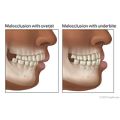Our Health Library information does not replace the advice of a doctor. Please be advised that this information is made available to assist our patients to learn more about their health. Our providers may not see and/or treat all topics found herein.
Topic Contents
Malocclusion and Orthodontics
Condition Basics
What is malocclusion?
Malocclusion means having crooked teeth or a "poor bite." Bite refers to the way the upper and lower teeth line up. In a normal bite, the upper teeth sit slightly forward of the lower teeth. Very few people have a perfect bite.
Most of the time, malocclusion is a cosmetic problem, which means that people don't like the way their teeth look. But it can also have a serious impact on self-esteem. Plus, crooked teeth can be hard to take care of, which may lead to tooth decay or tooth loss. When malocclusion is severe, it can even cause problems with eating or speaking.
What causes it?
Malocclusion is usually caused by problems with the shape or size of the jaw or teeth. A common cause is having too much or too little room in the jaw. If a child's jaw is small, the teeth may grow in crowded or crooked. If there's too much space in the jaw, the teeth may drift out of place.
Other causes of malocclusion include thumb-sucking, pacifier use, and tooth loss. Long-term mouth breathing seems to be linked to malocclusion too, but how isn't exactly clear.
What are the symptoms?
The most obvious sign is teeth that are crooked or stick out. But there are many different types of malocclusion. Some people have buck teeth (called an overjet). This means that the upper front teeth are pushed outward. Others have an underbite. Their lower front teeth sit farther forward than their upper front teeth.
How is it diagnosed?
A dentist usually checks for malocclusion in children during regular dental visits. If the jaw or teeth are out of line, the dentist may suggest a visit to an orthodontist.
An orthodontist will:
- Ask questions about your or your child's past health.
- Check the mouth and teeth.
- Take X-rays and photos of the face and teeth.
- Make a plaster model or digital image of the teeth.
How is malocclusion treated?
Orthodontic treatment can correct the way teeth and jaws line up. That may help a person feel better about their appearance, and also makes the teeth easier to take care of. Dentists who are specially trained to correct malocclusion are called orthodontists. They use a variety of tools and techniques to move teeth, and sometimes the jaw, into the right position.
In children and teens, crowding in the mouth is the most common problem. So the first step in treatment may be to remove some baby teeth to make room for the permanent teeth to grow in. Orthodontists avoid removing permanent teeth when possible.
Some children may need an early treatment called growth modification. For this, the child wears a device that helps move the jaw into a better position. This treatment works best during a child's growth spurts.
Braces or other devices can be used to slowly move the teeth to correct the bite. This can also help move a child's jaw into the right position.
Braces or other devices can straighten an adult's teeth too.
Teeth naturally tend to drift out of place, even after treatment with braces. So you may need to wear a device in your mouth called a retainer to keep your teeth from moving. Some people need to use retainers for many years after treatment.
Related Information
Credits
Current as of: September 30, 2025
Author: Ignite Healthwise, LLC Staff
Clinical Review Board
All Ignite Healthwise, LLC education is reviewed by a team that includes physicians, nurses, advanced practitioners, registered dieticians, and other healthcare professionals.
Current as of: September 30, 2025
Author: Ignite Healthwise, LLC Staff
Clinical Review Board
All Ignite Healthwise, LLC education is reviewed by a team that includes physicians, nurses, advanced practitioners, registered dieticians, and other healthcare professionals.
This information does not replace the advice of a doctor. Ignite Healthwise, LLC disclaims any warranty or liability for your use of this information. Your use of this information means that you agree to the Terms of Use and Privacy Policy. Learn how we develop our content.
To learn more about Ignite Healthwise, LLC, visit webmdignite.com.
© 2024-2025 Ignite Healthwise, LLC.







